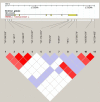Germline mutation in RNASEL predicts increased risk of head and neck, uterine cervix and breast cancer
- PMID: 18575592
- PMCID: PMC2424240
- DOI: 10.1371/journal.pone.0002492
Germline mutation in RNASEL predicts increased risk of head and neck, uterine cervix and breast cancer
Abstract
THE BACKGROUND: Ribonuclease L (RNASEL), encoding the 2'-5'-oligoadenylate (2-5A)-dependent RNase L, is a key enzyme in the interferon induced antiviral and anti-proliferate pathway. Mutations in RNASEL segregate with the disease in prostate cancer families and specific genotypes are associated with an increased risk of prostate cancer. Infection by human papillomavirus (HPV) is the major risk factor for uterine cervix cancer and for a subset of head and neck squamous cell carcinomas (HNSCC). HPV, Epstein Barr virus (EBV) and sequences from mouse mammary tumor virus (MMTV) have been detected in breast tumors, and the presence of integrated SV40 T/t antigen in breast carcinomas correlates with an aggressive phenotype and poor prognosis. A genetic predisposition could explain why some viral infections persist and induce cancer, while others disappear spontaneously. This points at RNASEL as a strong susceptibility gene.
Methodology/principal findings: To evaluate the implication of an abnormal activity of RNase L in the onset and development of viral induced cancers, the study was initiated by searching for germline mutations in patients diagnosed with uterine cervix cancer. The rationale behind is that close to 100% of the cervix cancer patients have a persistent HPV infection, and if a defective RNase L were responsible for the lack of ability to clear the HPV infection, we would expect to find a wide spectrum of mutations in these patients, leading to a decreased RNase L activity. The HPV genotype was established in tumor DNA from 42 patients diagnosed with carcinoma of the uterine cervix and somatic tissue from these patients was analyzed for mutations by direct sequencing of all coding and regulatory regions of RNASEL. Fifteen mutations, including still uncharacterized, were identified. The genotype frequencies of selected single nucleotide polymorphisms (SNPs) established in the cervix cancer patients were compared between 382 patients with head and neck squamous cell carcinomas (HNSCC), 199 patients with primary unilateral breast cancer and 502 healthy Danish control individuals. We found that the genotype frequencies of only one of the 15 mutations, the yet uncharacterized 5'UTR mutation rs3738579 differed significantly between cancer patients and control individuals (P-value: 4.43x10(-5)).
Conclusion/significance: In conclusion, we have discovered an increased risk, a heterozygous advantage and thereby a protective effect linked to the RNASEL SNP rs3738579. This effect is found for patients diagnosed with carcinoma of the uterine cervix, HNSCC, and breast cancer thus pointing at RNASEL as a general marker for cancer risk and not restricted to familial prostate cancer.
Conflict of interest statement
Figures



Similar articles
-
Germline mutations in the ribonuclease L gene in families showing linkage with HPC1.Nat Genet. 2002 Feb;30(2):181-4. doi: 10.1038/ng823. Epub 2002 Jan 22. Nat Genet. 2002. PMID: 11799394
-
Mutation screening and association study of RNASEL as a prostate cancer susceptibility gene.Br J Cancer. 2005 Mar 28;92(6):1159-64. doi: 10.1038/sj.bjc.6602401. Br J Cancer. 2005. PMID: 15714208 Free PMC article.
-
Arg462Gln sequence variation in the prostate-cancer-susceptibility gene RNASEL and age of onset of hereditary non-polyposis colorectal cancer: a case-control study.Lancet Oncol. 2005 Aug;6(8):566-72. doi: 10.1016/S1470-2045(05)70253-9. Lancet Oncol. 2005. PMID: 16054567
-
Implications for RNase L in prostate cancer biology.Biochemistry. 2003 Feb 25;42(7):1805-12. doi: 10.1021/bi027147i. Biochemistry. 2003. PMID: 12590567 Review.
-
Human papillomavirus in head and neck squamous cell carcinoma: are some head and neck cancers a sexually transmitted disease?Curr Opin Oncol. 1999 May;11(3):191-9. doi: 10.1097/00001622-199905000-00010. Curr Opin Oncol. 1999. PMID: 10328594 Review.
Cited by
-
RNASEL and MIR146A SNP-SNP interaction as a susceptibility factor for non-melanoma skin cancer.PLoS One. 2014 Apr 3;9(4):e93602. doi: 10.1371/journal.pone.0093602. eCollection 2014. PLoS One. 2014. PMID: 24699816 Free PMC article.
-
RNase-L deficiency exacerbates experimental colitis and colitis-associated cancer.Inflamm Bowel Dis. 2013 May;19(6):1295-305. doi: 10.1097/MIB.0b013e318281f2fd. Inflamm Bowel Dis. 2013. PMID: 23567782 Free PMC article.
-
2-5A-Mediated decay (2-5AMD): from antiviral defense to control of host RNA.Crit Rev Biochem Mol Biol. 2022 Oct-Dec;57(5-6):477-491. doi: 10.1080/10409238.2023.2181308. Epub 2023 Mar 20. Crit Rev Biochem Mol Biol. 2022. PMID: 36939319 Free PMC article. Review.
-
Inferring gene-phenotype associations via global protein complex network propagation.PLoS One. 2011;6(7):e21502. doi: 10.1371/journal.pone.0021502. Epub 2011 Jul 25. PLoS One. 2011. PMID: 21799737 Free PMC article.
-
CRISPR/Cas9 model of prostate cancer identifies Kmt2c deficiency as a metastatic driver by Odam/Cabs1 gene cluster expression.Nat Commun. 2024 Mar 7;15(1):2088. doi: 10.1038/s41467-024-46370-0. Nat Commun. 2024. PMID: 38453924 Free PMC article.
References
-
- Zhou A, Hassel BA, Silverman RH. Expression cloning of 2-5A-dependent RNAase: a uniquely regulated mediator of interferon action. Cell. 1993;72:753–765. - PubMed
-
- Xiang Y, Wang Z, Murakami J, Plummer S, Klein EA, et al. Effects of RNase L mutations associated with prostate cancer on apoptosis induced by 2′,5′-oligoadenylates. Cancer Res. 2003;63:6795–6801. - PubMed
-
- Rusch L, Zhou A, Silverman RH. Caspase-dependent apoptosis by 2′,5′-oligoadenylate activation of RNase L is enhanced by IFN-beta. J Interferon Cytokine Res. 2000;20:1091–1100. - PubMed
-
- Roy FL, Salehzada T, Bisbal C, Dougherty JP, Peltz SW. A newly discovered function for RNase L in regulating translation termination. Nat Struct Mol Biol. 2005;12:505–512. - PubMed

